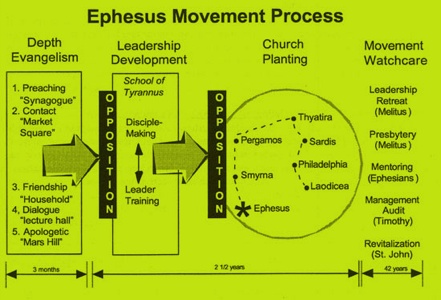A Great Resource at this Site: The Movement – Redeemer Urban Church Planting Center e-Newsletter:
WHAT DOES IT TAKE TO START A MOVEMENT?
J. Allen Thompson looks at the one in Ephesus
“The word of the Lord spread widely and grew in power.” (acts 19:20). G. Campbell Morgan summarizes the power of the Gospel and of God’s instrument, Paul. “Paul then at Ephesus was making tents, conducting a great course of apologetics for Christianity, fulfilling the function of the pastor, watching over the flock, admonishing with tears and teaching from house to house.”
But he was also directing a great missionary enterprise to that whole region round about Ephesus.
In all probability it was here in Ephesus that Philemon was brought to Christ and sent to Colosse for the formation of that Church. Probably also it was at Ephesus that fellow-worker with Paul in prayer, Epaphras, who watched over another Church, was first brought to Christ. Think of this man. Think of the forces in Ephesus against him, against his Gospel, against his Lord. How did he finish that paragraph in the Corinthian letter? “If I must needs glory, I will glory of the things that concern my weakness.’ (II Cor. 11:30) The process can be pictured as follows:
1. Paul the movement leader: evangelist, teacher, trainer, model, mentor.
2. Intensive, aggressive evangelistic outreach using multiple approaches preaching (18:24, 19:8), teaching (18:25), personal evangelism (18:26), counseling (18:27), writings (18:27), apologetics and polemics (18:28, 19:8), question and answer approach (19:1-5), power encounters with spiritual forces (19:11), public meetings (19:9).
3. Extensive biblical training in ministry that blanketed Asia Minor with the gospel. It is probably that one of the products of this training was Epaphras who apparently evangelized the cities of Lycus valley and founded the churches of Colosse, Hierapolis and Laodicea. At least seven churches were started in a two-year period.
4. People-oriented ministries: People were counseled and taught concerning the Way. Money was not the first matter of concern.
5. Momentum driven by unity and vision of love: Twenty-six names of workers are mentioned as associates of Paul in his ministry at Ephesus. As paul had his last meeting in Miletus “they began to week aloud and embraced Paul, and repeatedly kissed him” (10:37-8). There was evident harmonious fellowship between his panorama of cross-cultural workers.
6. Watchcare ministries: Paul realized that bond between the churches and leaders was still fragile and needed to be strengthened. So he convened the meeting. He brought the group of leaders together and re-enforced their deep bonds in Christ. This leadership retreat at Miletus was more than a tearful goodbye. It was the gathering of leaders of the regional church in Asia Minor to encourage, instruct, warn, build, and commend to God. Indeed it was a proto-presbytery with a mix of leaders from Paul’s ministry.
In addition, Paul exercised watchcare through writing letters. Ephesians (61 AD) was written as a circular letter to these churches seven years after the Melitus retreat to deepen their understanding of the nature of Christ’s church. Lesson: Planting churches without providing accountability structures and follow-up for leaders results in loss of momentum and eventual stagnation.
Having reviewed the Ephesus case study, what assumptions do we bring to church planting movement thinking today? The following are foundational:
1. Christians who grasp the gospel and are thus saturated by a basic Reformation world and life view and are living and city-building in the city in sufficient numbers can change a major city.
2. Churches that are evangelistically focused and worship-discipleship oriented can train and send hundreds of Christians into the marketplace. To make a difference in a city, we probably need to see one church for every 1000 people.
3. Renewing and revived churches spread the dynamics of spiritual renewal into churches of the region. These dynamics include individual renewal (repentance for self-righteousness, grasp and experience justification and adoption, humble-boldness, assurance and power); corporate renewal dynamics (depth proclamation of the gospel, kingdom-centered prayer, revived leaders) and corporate renewal signs (theological depth, dynamic worship, intimate fellowship, assertive evangelism and social concern). Without renewal by God’s grace, churches stagnate and die.
4. Intentional cooperation with other churches and Christians from many major cultural institutions (community development and institutions for cultural enrichment) can impact the city or region with the Gospel.
5. A church-multiplying and impacting movement takes time — at least 20-50 years. Revival becomes widespread in the first generation bringing hundreds into the Kingdom of God; in the second generation Christians rise and make their influence known. The third generation really begins to see the full harvest of a multiplication movement.
J. Allen Thompson is a consultant to the Redeemer Church Planting Center and President of the International Church Planting Center.
